Mt. Sinai
Part 4
By Mary Nell Wyatt
(Originally published in
Newsletter #6, dated January 1994)
THE EVIDENCE AT THE MOUNTAIN
The first thing Ron noticed when he saw Jebel el Lawz in 1984, just prior to his arrest, was that the high peak of the mountain range was distinctly black. When one stands at the base of the mountain- just outside the boundary markers which we will discuss a little later, the high peak that can be seen looks like it is made of coal. When "Abu Hesham" climbed the mountain a little north of this peak, and looked southward, the entire line of "black" could be seen. (See color photo section). It looks exactly as if the very top portion of the entire top of the Lawz mountain had been evenly scorched-
EXO 19:18 And mount Sinai was altogether on a smoke, because the LORD descended upon it in fire:
The "Bounds" Set by Moses
EXO 19:12 And thou shalt set bounds unto the people round about, saying, Take heed to yourselves, that ye go not up into the mount, or touch the border of it: whosoever toucheth the mount shall be surely put to death:
The area of the "holy precinct", the section Moses was directed by God to enclose in "bounds" at the foot of the mountain, is enclosed by huge, 18 foot diameter round columns. These cannot be seen except upon close examination because over the intervening 3,400 years, soil and rock has accumulated around them raising the ground level.
Today, only the tops of a few can be seen, sticking up through the ground just a few inches. It was one of columns that was partially excavated when Ron and Dave were there in 1985. Their construction is as follows: the outer wall, constructed of brick-sized rocks, is 18 foot in diameter; and the construction is similar to the large Egyptian columns. Within this enclosed outer wall is another interior wall, several feet smaller. In between these 2 walls, other stones of the same size are placed vertically.
Their location can be seen quite easily, as the soil covering them drops off about 20 feet along their entire course. (See diagram). The evidence shows that they extended across from north to south in a fairly direct line, then turn and follow the dried riverbed that cuts through (this riverbed begins high up in the mountain, comes down the side, and extends out eastward).
See Deu. 9:21. The boundary columns then begin again along the southern edge of the riverbed, travel east, turn south and then turn westward, where they extend all the way to the southern side of the mountain.
The Holy Precinct
When viewed looking west, the entire area of the holy precinct can be seen. In immediate view to the right is a portion of the mountain which features double "peaks". Just below these peaks, in the face of the mountain, can be seen a cave. On the far right peak, there are 2 extremely large boulders with a solitary tree growing between them. This strange tree which seemingly is growing out of the granite, is one of the first things Ron noticed when he first saw this mountain, and it is this tree which positively identifies the mountain. In an area with miles and miles of mountains, there is no mistaking this particular site- when you see the tree, you know you are there. In fact, "Abu Hesham" told Ron that it was only when he looked up and saw the tree between the massive granite boulders that he realized he was at the right mountain!
3 Archaeological Requirements
In archaeology, there are three things which are usually present in an archaeologically important site- first, of course, is physical evidence. Second, is ancient inscriptions in the area, identifying or connection the particular discovery with the area. Finally, and very importantly, are the study of local traditions passed down through the natives of the region. As we mentioned earlier, the Bedouin, Ibrahim Frich, told Ron and Dave that "Jebel Muss Henna", when they were at Jebel el Lawz. In other words, the local people even refer to this mountain as "Moses’ mountain".
But there is a reference in a book written about 650 AD, which speaks of a tree on Sinai- and the book from which this is taken, was written by a man who lived and knew western Saudi Arabia. This book is the Koran. The speaker in this passage is supposed to be God, or Allah, who refers to himself in the plural as He states: "We produced for you...a tree issuing from the Mount of Sinai that bears oil and seasoning..." ("The Koran", translated by Arthur J. Arberry, Chapter (Sura) "The Believers", para. 20.)
We know for a fact that Mohammed, the author of the Koran, visited this area at least once. For in about 631 AD, he concluded peace treaties with the Christian chief of Aqabah and the Jewish tribes in the oases of Maqna. This is the immediate area to the north and south of Jebel el Lawz- within walking distance.
The "Brook that Descended out of the Mount"
On the face of the mountain, as looking from outside the Holy Precinct, there extends the evidence of an ancient river or brook, that originated high in the mountain. The waters issued forth, spilling down through the southern part of the holy precinct, turning east and flowing to the edge of the boundary markers, then turning and flowing north. The path is still visible today. The Biblical account tells of this:
DEU 9:21 And I took your sin, the calf which ye had made, and burnt it with fire, and stamped it, and ground it very small,...and I cast the dust thereof into the brook that descended out of the mount.
And again, as we read the Koran, it appears that the peoples of this area knew the site of Mt. Sinai and this "brook" very well. "Moses...said...'I observe a fire,...When he came to it, a voice cried from the right bank of the watercourse, in the sacred hollow, coming from the tree: Moses, I am God..." (Ibid., Chapter 'The Story', para. 29-30.) This is an amazing description of a scene which perfectly fits the evidence from the site! The "sacred hollow" describes the area at the foot of the blackened mountain, which is protected on three sides by the mountains. The tree is certainly to the right of the river and again fits.
Equally as interesting, from the point of being local Arabian tradition as captured in the Koran, is the following: "Thou wast not upon the western side when We decreed to Moses the commandment, nor wast thou of those witnessing..." (Ibid, para. 44) This illustrative language says that the people whom are being addressed were not on the "western" or opposite side of the mountain, neither were they on the eastern side, which is where "those witnessing" were located!
The Golden Calf Altar
As we said, the evidence which caused the Saudi archaeologist to say that this was a major archaeological discovery, was the petroglyphs on the altar which is located east of the holy precinct- in fact, from the top of the mountain, looking down toward the sacred area, this altar is almost directly straight ahead. But it is perhaps a mile or more from the base of the mountain.
As we read the Biblical account of the event, we can see that this site fits the description given perfectly:
EXO 32:15 And Moses turned, and went down from the mount, and the two tables of the testimony were in his hand: the tables were written on both their sides;...17 And when Joshua heard the noise of the people as they shouted, he said unto Moses, There is a noise of war in the camp. 18 And he said, It is not the voice of them that shout for mastery, neither is it the voice of them that cry for being overcome: but the noise of them that sing do I hear. 19 And it came to pass, as soon as he came nigh unto the camp, that saw the calf, and the dancing: and Moses’ anger waxed hot, and he cast the tables out of his hands, and brake them beneath the mount. 20 And he took the calf which they had made, and burnt it in the fire, and ground it to powder, and strawed it upon the water, and made the children of Israel drink of it.
We can visualize Moses and Joshua looking out over the area from the plateau, getting ready to begin their final descent. They look out over the uninhabited holy precinct, and just outside the boundary columns, the people are in a great commotion, singing and dancing. And just beyond the great multitude, nestled close to a small hill, is the golden calf altar.
As they walk through the holy precinct and near the camp, just inside the borders of the holy precinct, they can clearly see the golden calf high upon the altar. Moses throws down the Tables of Stone, just inside the Holy Precinct, but in the sight of the people. He keeps walking straight ahead, directly to Aaron and the altar. Taking the golden calf, he throws it in the fire which Aaron had used to melt the gold in order to form the calf (see verse 24). With the calf perhaps melted down into a formless "blob" (showing what a "powerful god" it really is), he takes it and climbs upon the altar Aaron built and grinds it down into dust. He then takes the large pile of gold dust to the stream which flows from the mountain and strews it in the water at the place where the stream flows out of the Holy Precinct. Since no one can venture beyond the borders set about the Holy Precinct, no one who drinks the water can escape the pollution of the gold in it- and the entire camp probably experienced tremendous stomach problems from the gold.
Thus far, the evidences at Jebel el Lawz fit the Biblical description perfectly!
The Altar at the Foot of the Mountain
If we stand just outside the boundary columns and look directly west into the Holy Precinct, near the foot of the mountain to the left is an altar made of uncut stones. Standing in front of this altar, it is about shoulder high to Ron- but if you walk around behind it, the slope of the ground beneath it causes it to only be little above knee high to Ron.
EXO 20:25 And if thou wilt make me an altar of stone, thou shalt not build it of hewn stone: for if thou lift up thy tool upon it, thou hast polluted it. 26 Neither shall thou go up by steps unto mine altar, that thy nakedness be not discovered thereon.
Again, the altar fits the Biblical description. The stones are natural in shape- no tool has been used to shape its stones. It has no steps-Moses could easily make the offerings upon it when he stood behind it, which would have him facing the congregation.
Extending out from this altar at about a 90 degree angle, is a sort of walled in area. Perhaps this was where the animals were slaughtered, or it may have been the foundation for some type of tent/building.
The 12 Pillars
EXO 24:4 And Moses wrote all the words of the LORD, and rose up early in the morning, and builded an altar under the hill, and twelve pillars, according to the twelve tribes of Israel.
With no more information than this as to the 12 pillars, we look to the Hebrew word translated to read "pillars"- it is "matstsebah". Could this be the origin of the word "massebah", which is a term for a one-piece, standing stone pillar? If so, we would assume that these pillars would be simple standing stones, not columns constructed out of many rocks fitted together. But we can go to another example:
JOS 4:8 And the children of Israel did so as Joshua commanded, and took up twelve stones out of the midst of Jordan, as the LORD spake unto Joshua, according to the number of the tribes of the children of Israel, and carried them over with them unto the place where they lodged, and laid them down there. 9 And Joshua set up twelve stones in the midst of Jordan, in the place where the feet of the priests which bare the ark of the covenant stood: and they are there unto this day.
These were one piece stones. So, we can expect that the "pillars" Moses erect were not constructed out of numerous rocks fit together. And in the Holy Precinct, to the far right and near the front (looking westward into the area) there is a semicircle of 12 large granite boulders, about 6 foot wide and 9 foot tall (this is an estimate based on the drop in ground level). These are, like the 18 foot diameter boundary columns, covered by alluvial soil, washed into the area by seasonal showers and only the tops are visible.
The White Marble Shrine
Near the altar at the base of the mountain, are the remains of some type of shrine built of pure white, polished marble. The style of the remains indicates it was from a much later date- it was round, with 6 sets of double columns at even intervals. Its roof was a polished dome. There are quite a number of these broken columns still lying in the area, and were seen by Ron on his first trip to the site in 1984. From the inscriptions he saw, Ron believes this and the columns on the beaches were erected by Solomon.
Rephidim
Just over the western side of the mountain range, opposite the Holy Precinct, these is an area which features an incredible, 5-6 story rock perched upon a hill that it about 200 feet high. This rock is split through the middle and displays the pattern of water erosion and evidence that numerous streams came forth in several directions.
EXO 17:6 Behold, I will stand before thee there upon the rock in Horeb; and thou shalt smite the rock, and there shall come water out of it, that the people may drink....
About 200 yards from this rock is another altar, similar in construction to the one in the Holy Precinct.
EXO 17:15 And Moses built an altar,...
his area also features an immense plain area in which the battle with the Amaleks could have taken place.
The evidence is overwhelming- we have only touched on a small amount of the archaeological evidence at this site. When we can do so without compromising "Abu Hesham’s" safety, everything will be made public, and available in video and publications. For now, we must continue to be "patient"!
HOME
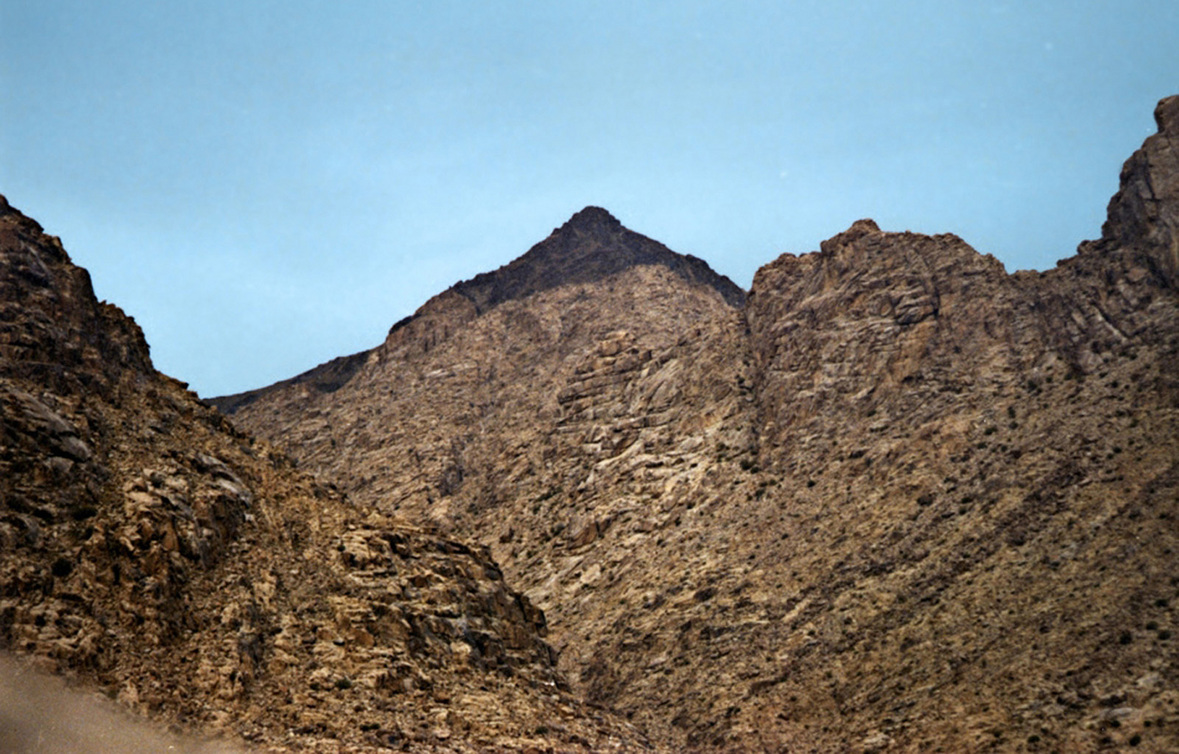
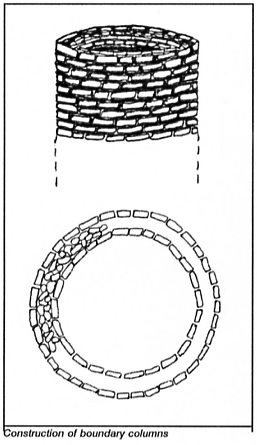
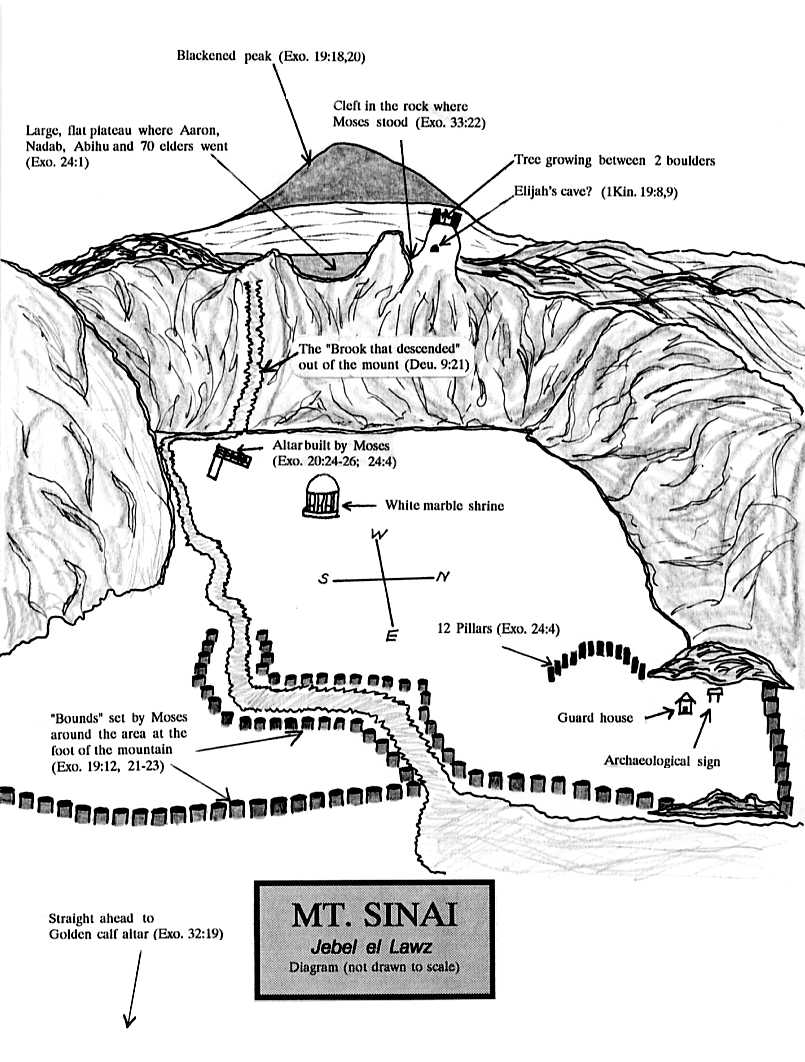
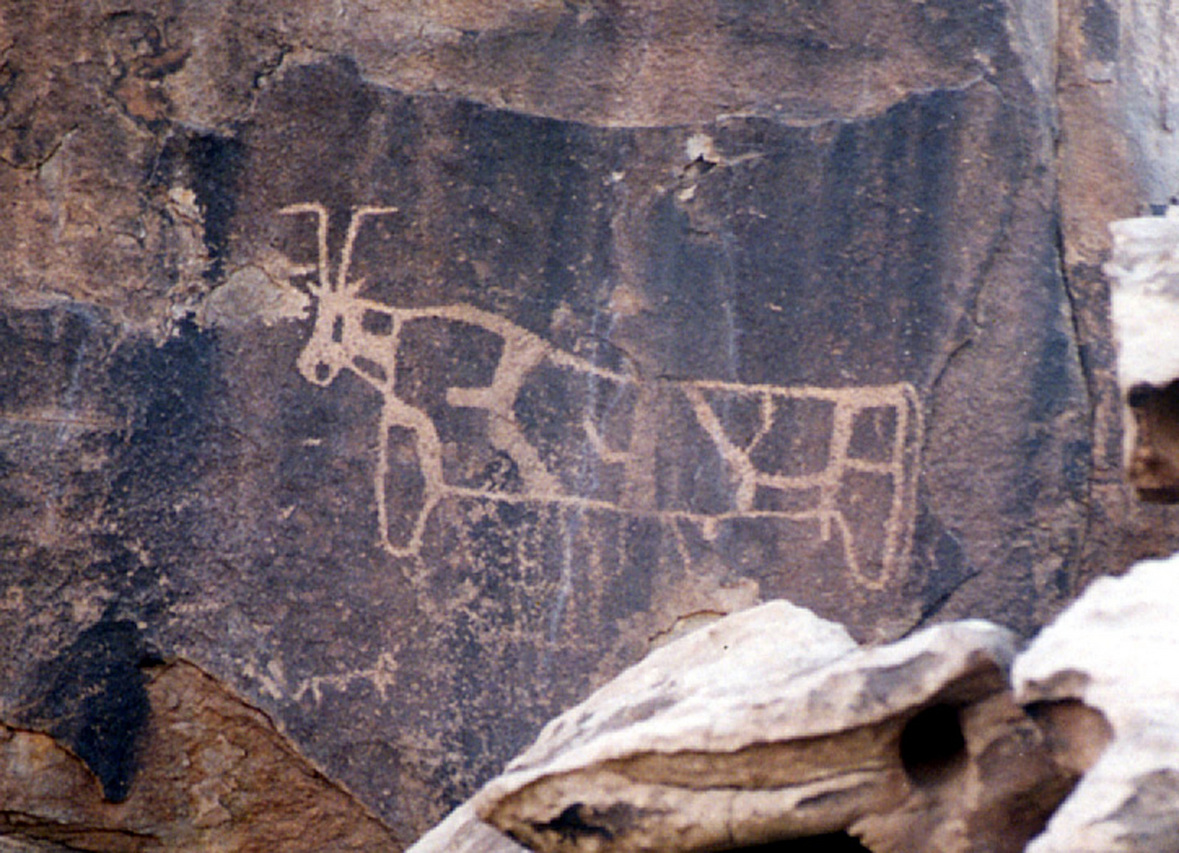

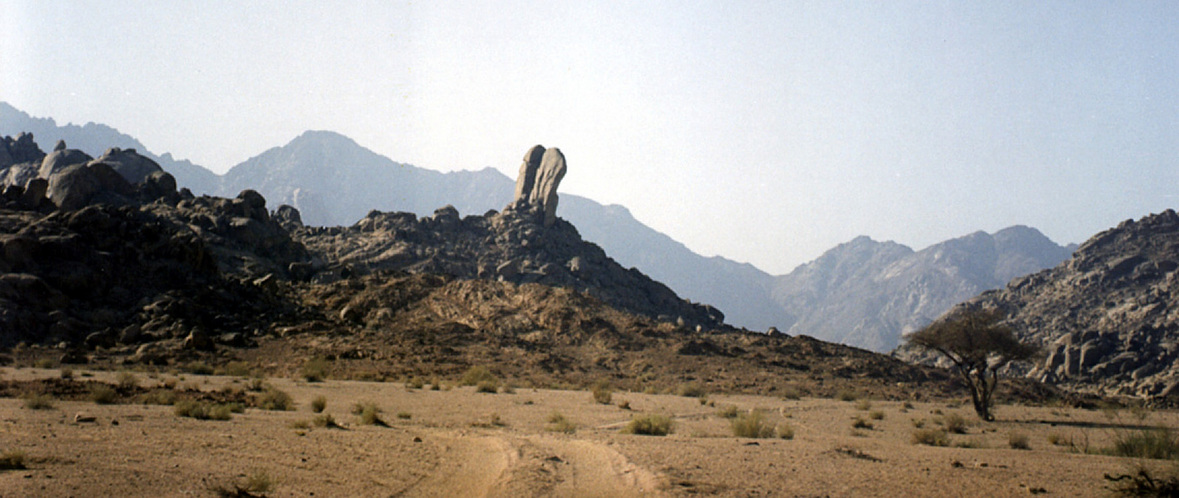
The Discoveries of Ron Wyatt

Ron Wyatt Discoveries by Ron Wyatt is licensed under a Creative Commons Attribution-NonCommercial-NoDerivatives 4.0 International License.
Based on a work at ronwyatt.com.
Permissions beyond the scope of this license may be available at michelle@ronwyatt.com.